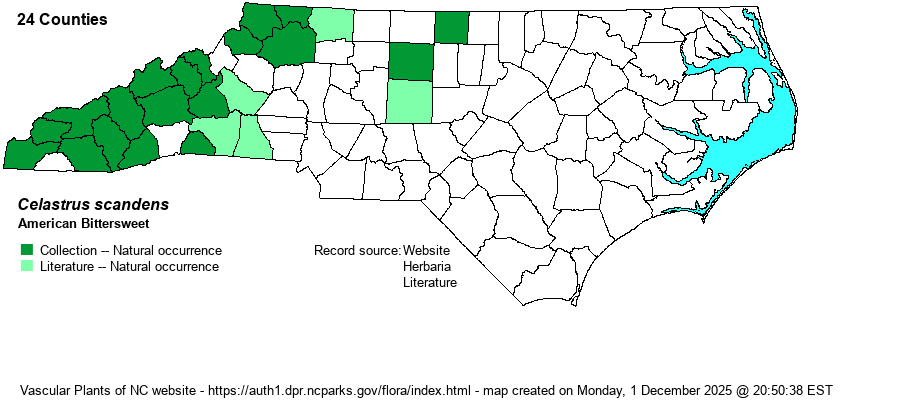| Author | L. | |
| Distribution | Present over most of the Mountains, and widely scattered in the western and central Piedmont. No known records east of Caswell and Randolph counties.
This is a Northern species occurring across southern Canada and south to central NC, southern AL, and parts of TX. Records for most counties south to PA, and MO, but very spotty range southward.
| |
| Abundance | Strongly declining since 2000, owing to competition from (and likely hybridization with) the aggressive non-native C. orbiculatus. Probably formerly uncommon in the Mountains, but rare now, and now very rare to rare in the western and west-central Piedmont. This is a State Endangered species. (Do not be fooled into thinking that this is not a scarce plant in the state, as it has been recorded from about 25 counties; many of these are old records, and most of them contain only a very small population or two.) | |
| Habitat | In NC, the species is restricted to rich forested soil, over mafic rocks. The forests can be somewhat rocky and dry, but it prefers moist slopes. It occurs in Basic Mesic Forests, Rich Cove Forests, and other such mafic forest types. It typically does not grow along forested borders, where its exotic “cousin” grows. |
| Phenology | Blooms in May and June, and fruits in August and September. | |
| Identification | This is a deciduous woody vine that sprawls over other vegetation, to a length of up to 20 feet. In the state, it is not a typical high-climbing vine, but instead tends to grows more horizontally or diagonally on other herbs or shrubs/saplings. It has alternate, elliptical leaves – noticeably longer than wide, with a somewhat acuminate tip; leaves are slightly serrated and reach about 3 inches in length. The inflorescence is a terminal cluster of many small dull greenish flowers that are not conspicuous. However, by late summer, the flowers have “turned into” orange capsules about 3/8-inch across, each of which splits open to reveal a red “berry”. To the novice, the inflorescence would seem to clinch the identification. However, the exotic Oriental Bittersweet (C. orbiculatus), which was rare at the time the RAB (1968) was written, is now often very common in the mountains and locally downstate. This weed is much more numerous than is the native species, and it grows mainly along wooded borders, fencerows, and other sunny or partly sunny places; however, it can and does grow into the shade of some rich forests. The exotic species has more rounded/orbicular leaves with a more sharply acuminate tip and has inflorescences in leaf axils – scattered along the stem – as opposed to only terminal inflorescences. All biologists, not just beginners, need to be cautious and careful when documenting a new location for C. scandens, as it can be easy to be incorrect in your identification without a specimen or good photographs, especially without the inflorescence. | |
| Taxonomic Comments | None
| |
| Other Common Name(s) | Occasionally named as just Bittersweet, but this is not suitable, as the Oriental Bittersweet is now often abundant; a modifier name is needed to distinguish the two species. | |
| State Rank | S2? | |
| Global Rank | G5 | |
| State Status | E | |
| US Status | | |
| USACE-agcp | FACU link |
| USACE-emp | FACU link |

